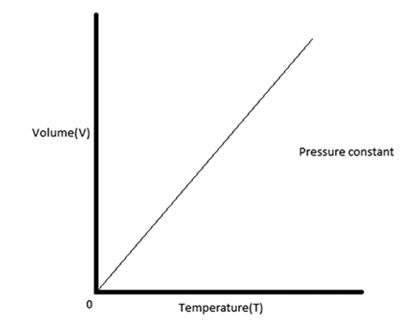
How can I graph Charles law?
Answer
462.9k+ views
Hint: The gas law which contains terms like temperature (T), pressure (P), volume (V) gives a relation between them, which is PV = nRT. This is also known as the ideal gas law.
Complete step by step answer:
We know that the expression for the ideal gas law is mentioned below:
PV = nRT
Where, P is the pressure of the gas
V is the volume of the gas
N is the number of moles of gas
R is the universal gas constant
T is the temperature of the gas
Charles law: according to this law the volume of an ideal gas changes with the change in the absolute temperature, when the pressure of the system is constant throughout the experiment. It is the ratio of volume of temperature where the pressure is always constant.
\[\dfrac{{{V}_{1}}}{{{T}_{1}}}=\dfrac{{{V}_{2}}}{{{T}_{2}}}\]
Pressure and number of moles are constant.
The graph of Charles law is as follows:

Additional Information .
- Boyle’s law: According to this law at the constant temperature, the pressure applied to an ideal gas is inversely proportional to the volume of the system. This means that the product of pressure and volume is constant.
\[{{P}_{1}}{{V}_{1}}={{P}_{2}}{{V}_{2}}\]
Temperature is constant.
- Avogadro’s law: according to this law at constant pressure and absolute temperature, the number of moles is directly proportional to the volume of the gas. This means that the ratio of volume and number of moles is constant.
\[\dfrac{{{V}_{1}}}{{{n}_{1}}}=\dfrac{{{V}_{2}}}{{{n}_{2}}}\]
Note: If we combine Boyles and Charles law a new equation is formed:
\[\dfrac{{{P}_{1}}{{V}_{1}}}{{{T}_{1}}}=\dfrac{{{P}_{2}}{{V}_{2}}}{{{T}_{2}}}\]
In this equation pressure, volume and temperature all are variables and also the product of pressure and volume in the reaction changes proportionally with the absolute temperature.
Complete step by step answer:
We know that the expression for the ideal gas law is mentioned below:
PV = nRT
Where, P is the pressure of the gas
V is the volume of the gas
N is the number of moles of gas
R is the universal gas constant
T is the temperature of the gas
Charles law: according to this law the volume of an ideal gas changes with the change in the absolute temperature, when the pressure of the system is constant throughout the experiment. It is the ratio of volume of temperature where the pressure is always constant.
\[\dfrac{{{V}_{1}}}{{{T}_{1}}}=\dfrac{{{V}_{2}}}{{{T}_{2}}}\]
Pressure and number of moles are constant.
The graph of Charles law is as follows:

Additional Information .
- Boyle’s law: According to this law at the constant temperature, the pressure applied to an ideal gas is inversely proportional to the volume of the system. This means that the product of pressure and volume is constant.
\[{{P}_{1}}{{V}_{1}}={{P}_{2}}{{V}_{2}}\]
Temperature is constant.
- Avogadro’s law: according to this law at constant pressure and absolute temperature, the number of moles is directly proportional to the volume of the gas. This means that the ratio of volume and number of moles is constant.
\[\dfrac{{{V}_{1}}}{{{n}_{1}}}=\dfrac{{{V}_{2}}}{{{n}_{2}}}\]
Note: If we combine Boyles and Charles law a new equation is formed:
\[\dfrac{{{P}_{1}}{{V}_{1}}}{{{T}_{1}}}=\dfrac{{{P}_{2}}{{V}_{2}}}{{{T}_{2}}}\]
In this equation pressure, volume and temperature all are variables and also the product of pressure and volume in the reaction changes proportionally with the absolute temperature.
Recently Updated Pages
The correct geometry and hybridization for XeF4 are class 11 chemistry CBSE

Water softening by Clarks process uses ACalcium bicarbonate class 11 chemistry CBSE

With reference to graphite and diamond which of the class 11 chemistry CBSE

A certain household has consumed 250 units of energy class 11 physics CBSE

The lightest metal known is A beryllium B lithium C class 11 chemistry CBSE

What is the formula mass of the iodine molecule class 11 chemistry CBSE

Trending doubts
State the laws of reflection of light

One Metric ton is equal to kg A 10000 B 1000 C 100 class 11 physics CBSE

Difference Between Prokaryotic Cells and Eukaryotic Cells

How do I convert ms to kmh Give an example class 11 physics CBSE

Describe the effects of the Second World War class 11 social science CBSE

Which of the following methods is suitable for preventing class 11 chemistry CBSE




